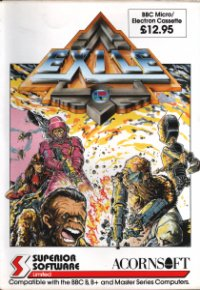
Exile is a single-player action-adventure video game originally published for the BBC Micro and Acorn Electron in 1988 by Superior Software and later ported to the Commodore 64, Amiga, CD32 and Atari ST, all published by Audiogenic. The game was designed and programmed by Peter Irvin and Jeremy Smith. It is often cited as one of the earliest examples of a Metroidvania game and featured "realistic gravity, inertia and object mass years before players understood the concept of a physics engine... an astounding level of AI, stealth-based gameplay, a logical ecosystem governing the world's creatures and a teleportation mechanic that feels startlingly like a predecessor to Portal".
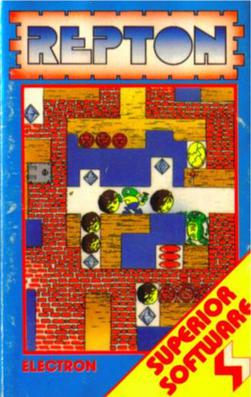
Repton is a video game originally developed by 16-year-old Briton Tim Tyler for the BBC Micro and Acorn Electron and released by Superior Software in 1985. The game spawned a series of follow up games which were released throughout the 1980s. The series sold around 125,000 copies between 1985 and 1990 with Repton 2 selling 35,000 itself. The games have since been remade for several modern systems, including iRepton for the iPhone / iPod Touch in 2010, and Android Repton 1, Android Repton 2 and Android Repton 3 from 2016 to 2018.

Superior Software Ltd is a video game publisher. It was one of the main publishers for the BBC Micro and Acorn Electron computers in the 1980s and early 1990s, and occasionally published software to the Commodore 64, Amiga, ZX Spectrum and Amstrad CPC. It currently releases games for Microsoft Windows, iOS and Android, mostly updates of its original games.

Citadel is a computer game developed by Michael Jakobsen for the BBC Micro, and released by Superior Software in 1985. It was also ported to the Acorn Electron. Centred around a castle, this platform game with some puzzle-solving elements requires players to find five hidden crystals and return them to their rightful place. It also features some outside areas external to the castle.

Dark Castle is a 1986 platform game for Macintosh that was originally published by Silicon Beach Software. The original game was designed and animated by Mark Pierce and programmed by Jonathan Gay with Real Sound by Eric Zocher. In Dark Castle, a young hero named Duncan tries to make his way to the evil Black Knight, dodging objects as well as solving occasional puzzles.

Frak! is a scrolling platform video game programmed by Nick Pelling for the BBC Micro and Acorn Electron and published by his own Aardvark Software in 1984. It was ported to the Commodore 64 the following year by "The B Team". The BBC and Electron versions were included on the Superior Software compilation Play It Again Sam 4 in 1987 and re-issued in budget form by Alternative Software in 1989.

Ricochet is an action-adventure game for the BBC Micro and Acorn Electron home computers, published by Superior Software in 1989. It was written by Neil Davidson and David Williams with some graphics work and level design by Nik Weston and Guy Burt.
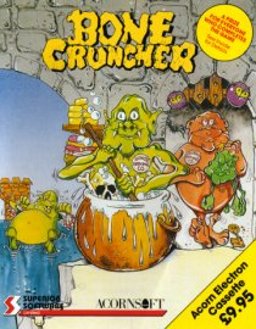
Bone Cruncher is a puzzle video game for the Acorn Electron, BBC Micro, and Commodore 64 first published by Superior Software in 1987. It uses the "rocks and diamonds" mechanics of Boulder Dash. An Amiga version was released in 1988.

Labyrinth is an action-adventure game published in 1984 by Acornsoft for the BBC Micro. Its author, Michael Mathison, describes it as:
an amalgam of what I'd seen and liked visually and I wanted to make something like an 'arcade' version of an adventure game - with lots of creatures and lots of running around shooting at things but also with some simple puzzle elements.
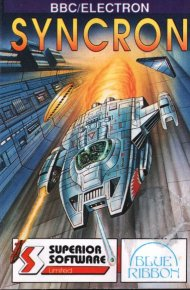
Syncron is a vertically scrolling shooter written by Gary Partis for the BBC Micro and Acorn Electron and published by Superior Software in 1987.
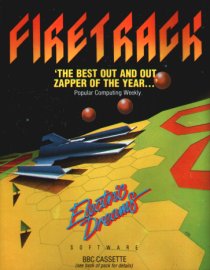
Firetrack is a vertically-scrolling shooter programmed by Nick Pelling and released for the BBC Micro and Commodore 64 platforms in 1987 by Electric Dreams Software. It was also ported to the Acorn Electron by Superior Software in 1989 as part of the Play It Again Sam 7 compilation. It resembles the 1984 arcade game Star Force in style and gameplay. The game was technically advanced and very well received by critics.

Palace of Magic is a platform game released on 1 November 1987 for the Acorn Electron and BBC Micro by Superior Software. Combining platform elements with problem solving, it similar gameplay to the earlier Citadel. Both are early examples of the Metroidvania genre.

Stryker's Run is a video game designed by Chris Roberts and Philip Meller for the BBC Micro and BBC Master which was published by Superior Software in 1986. It was also later converted to the Acorn Electron. It is a 2D side-scrolling action game. It was well received, particularly for its graphics.

Citadel 2 is a BBC Micro game developed by Symo for Superior Software. The sequel to Citadel, it is a platform game with puzzle solving elements. Like the original, the game's plot involves finding five gems hidden in various locations in a large fort, together with areas outside it and destroying them in a teleporter hidden at the bottom of a well. The game was released in 1993 on Superior's Play It Again Sam (PIAS) 18 compilation, which also included the games Nevryon, Holed Out, and E-Type.

Pipeline is a video game for the BBC Micro and Acorn Electron, originally published by Superior Software in 1988. It is an overhead view action role-playing game set on a mining platform. It was remade for Microsoft Windows as Pipeline Plus (2004).

Gauntlet III: The Final Quest is a home computer game by U.S. Gold and Tengen it was released in 1991 for the Amiga, Atari ST, Commodore 64, ZX Spectrum, and Amstrad CPC. Besides the standard four main Gauntlet characters, Thor, Thyra, Merlin, and Questor, four new playable characters were available: Petras, a rock man; Dracolis, a lizard man; Blizzard, an ice man; and Neptune, a Merman. The game is viewed from an isometric perspective and the cooperative multiplayer mode supports two-players.

Avencast: Rise of the Mage is an action role-playing game for Microsoft Windows developed by ClockStone and published by Lighthouse Interactive. The game heavily borrows elements of beat 'em ups. This is apparent from the ability to cast spells by rapidly combining movement inputs with mouse buttons. Alternatively short cuts can be assigned for easy access of spells. Also the scheme of recurring Boss fights reflects this relation. The inclusion of riddles shows the connection to adventure games.
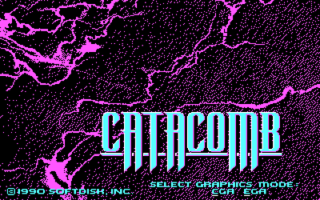
Catacomb is a 2-D top-down third-person shooter created, developed, and published by Softdisk. It was originally created for the Apple II, and later ported to the PC. It should not be confused with The Catacomb, which is the second game in the series. It supports EGA and CGA graphics.

Dunjunz is an action game made for the BBC Micro and Acorn Electron home computers and released by Bug-Byte in 1987. It is essentially a clone of the popular video game Gauntlet where players controlled fantasy characters from a top down view. Unlike Gauntlet, each of the characters is given their own viewport onto the dungeon and can explore independently.

Astérix is a 1991 platform game for the Master System. It is based on the comic book series Asterix and is part of a series of games based on this franchise.






















